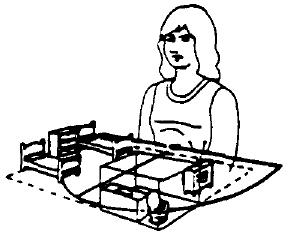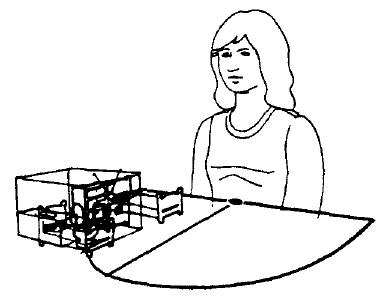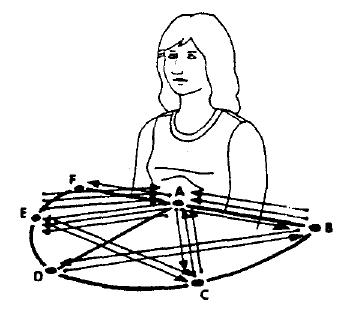1989 - Seeing Voices (17 page)
Read 1989 - Seeing Voices Online
Authors: Oliver Sacks

But aphasic signers are
not
impaired in other, nonlinguistic visual-spatial abilities. (Gesture, for example—the non-grammatical expressive movements we all make [shrugging the shoulders, waving good-bye, brandishing a fist, etc.]—is preserved in aphasia, even though Sign is lost, emphasizing the absolute distinction between the two. Patients with aphasia, indeed, can be taught to use ‘Amerindian Gestural Code,’ but cannot use Sign, any more than they can use speech.)
103
103. There is considerable evidence that signing may be useful with some autistic children who are unable or unwilling to speak; Sign may allow such children a degree of communication which had seemed unimaginable (Bonvilhan and Nelson, 1976). This may be in part, so Rapin feels, because some autistic children may have specific neurological difficulties in the auditory sphere, but much greater intactness in the visual sphere.
Though Sign cannot be of help with the aphasic, it
may
help the retarded and senile with very limited or eroded capacities for spoken language. This may be due in part to the graphic and iconic expressiveness of Sign, and in part to the relative motor simplicity of its movements, compared with the extreme complexity and vulnerability of the mechanism for speech.
Signers with right hemisphere strokes, in contrast, may have severe spatial disorganization, an inability to appreciate perspective, and sometimes neglect of the left side of space—but are not aphasic and retain perfect signing ability despite their severe visual-spatial deficits. Thus signers show the same cerebral lateralization as speakers, even though their language is entirely visuo-spatial in nature (and as such might be expected to be processed in the right hemisphere).
This finding, when one considers it, is both startling and obvious and leads to two conclusions. It confirms, at a neurological level, that Sign
is
a language and is treated as such by the brain, even though it is visual rather than auditory, and spatially rather than sequentially organized. And as a language, it is processed by the left hemisphere of the brain, which is biologically specialized for just this function.
The fact that Sign is based here in the left hemisphere, despite its spatial organization, suggests that there is a representation of ‘linguistic’ space in the brain completely different from that of ordinary, ‘topographic’ space. Bellugi provides a remarkable and startling confirmation of this. One of her subjects, Brenda 1., with a massive right hemisphere lesion, showed a profound neglect of the left side of space, so that when she described her room, she put everything, higgledy-piggledy, on the right side, leaving the left side entirely vacant. The left side of space—of topographic space—no longer existed for her (fig. 3a-b). But in the actual signing, she established spatial loci, and signed freely, throughout the signing space, including the left side (fig. 3c). Thus her perceptual space, her topographic space, a right hemisphere function, was profoundly defective; but her linguistic space, her syntax space, a left hemisphere function, was completely intact.
Thus there develops in signers a new and extraordinarily sophisticated way of representing space; a new
sort
of space, a formal space, which has no analogue in those of us who do not sign.
104
104. There may be other ways of establishing such a formal space, as well as a great enhancement of visual-cognitive function generally. Thus with the spread of personal computers in the past decade, it has become possible to organize and move logical information in (computer) ‘space,’ to make (and rotate, or otherwise transform) the most complex three-dimensional models or figures. This has led to the development of a new sort of expertise—a power of visual imagery (especially imagery of topological transforms) and visual-logical thinking which was, in the pre-computer age, distinctly rare. Virtually anyone can become a visual ‘adept’ in this way—at least, anyone under the age of fourteen. It is much more difficult to achieve visual-computational fluency after this age, as it is much more difficult to achieve fluent language. Parents find again and again that their children can become computer whizzes where they cannot—another example, perhaps, of ‘critical age.’ It seems probable that such enhancement of visual-cognitive and visual-logical functions requires an early shift to a left hemisphere predominance.
This reflects a wholly novel neurological development. It is as if the left hemisphere in signers ‘takes over’ a realm of visual-spatial perception, modifies it, sharpens it, in an unprecedented way, giving it anew, highly analytical and abstract character, making a visual language and visual conception possible.
105
105. Novel—yet potentially universal. For as in Martha’s Vineyard, entire populations, hearing and deaf alike, can become fluent native signers. Thus the capacity—the neuronal apparatus—to acquire spatial language (and all the nonlinguistic spatial capacities that go with this) is clearly present, potentially, in everyone.
There must be countless neuronal potentials that we are born with which can develop or deteriorate according to demand. The development of the nervous system, and especially of the cerebral cortex is, within its genetic constraints, guided and molded,
sculpted
, by early experience. Thus the capacity to discriminate phonemes has a huge range in the first six months of life, but then becomes restricted by the actual speech to which infants are exposed, so that Japanese infants become unable, for example, to discriminate anymore between an ‘I’ or an ‘r,’ and American infants, similarly, between various Japanese phonemes. Nor are we short on neurons; there is no danger that developing one potential will ‘use up’ a limited supply of neurons and prevent the development of other potentials. There is every reason to have the richest possible environment, linguistically as well as in every other way, during the critical early period of brain plasticity and growth.
 CORRECT SPATIAL LAYOUT
CORRECT SPATIAL LAYOUT
 DISTORTED SIGNED SPATIAL LAYOUT
DISTORTED SIGNED SPATIAL LAYOUT
 CORRECT SIGNED SYNTAX
CORRECT SIGNED SYNTAX
Figure
3. A massive lesion in the right cerebral hemisphere destroys Brenda I.’s ability to ‘map’ on the left side, but not her ability to use syntax. Figure (a) shows the actual layout of Brenda’s room, as it would be correctly signed. Figure (b): In describing her room, Brenda leaves the left side bare, and (mentally) piles all the furniture in the right side of the room. She can no longer even imagine ‘leftness.’ Figure (c): But in her actual signing, Brenda uses a full space, including the left side, to represent syntactic relations. (Reprinted by permission from
What the Hands Reveal About the Brain
, H. Poizner, E.S. Klima, & U. Bellugi. The MIT Press⁄Bradford Books, 1987.)
One must wonder whether this linguistic-spatial power is the only special development in signers. Do they develop other, nonlinguistic, visual-spatial powers? Does a new form of visual
intelligence
become possible? This question has led Bellugi and her colleagues to launch a fascinating study of visual cognition in deaf signers.
106
106. Bellugi et al., 1989.
They compared the performance of deaf, natively signing children with that of hearing, non-signing children on a battery of visual-spatial tests. In tests of spatial construction, the deaf children did much better than the hearing ones, and indeed, much better than ‘normal.’ There were similar findings with tests of spatial organization—the ability to perceive a whole from disorganized parts, the ability to perceive (or conceive) an object. Here again, deaf four-year-olds did extraordinarily well, getting scores that some hearing high school students could not match. With a test of facial recognition—the Benton test, which measures both facial recognition and spatial transformation—the deaf children were again markedly ahead of the hearing children, and far in advance of their chronological norms.
Perhaps the most dramatic test results have come from deaf and hearing children in Hong Kong, where Bellugi has investigated their ability to perceive and remember meaningless Chinese ‘pseudo-characters’ presented as swift patterns of light.
Here the deaf, signing children did startlingly well—and the hearing children were almost unable to do the task at all (see fig. 4). The deaf children, it seems, were able to ‘parse’ these pseudo-characters, to achieve a very complex spatial analysis, and this enormously facilitated their powers of visual perception, enabling them to ‘see’ the pseudo-characters at a glance. Even when the experiment was repeated with deaf and hearing American adults who had no knowledge of Chinese characters, the deaf signers did notably better.
These tests, in which signing children perform far above normal levels (a superiority that is especially marked in the first few years of life), all emphasize the special visual skills learned in acquiring Sign. As Bellugi notes, the spatial organization test involves not only the recognition and naming of objects, but also mental rotation, form perception, and spatial organization, all of which are relevant to the spatial underpinnings of Sign syntax. The ability to discriminate faces, and recognize subtle variations of facial expression, also carries extreme importance to the signer, since facial expression plays an important role in ASL grammar,
107
107. This linguistic use of the face is peculiar to signers, is quite different from the normal, affective use of the face, and, indeed, has a different neural basis. This has been shown very recently in experimental studies by David Corina. Pictures of faces, with expressions that could be interpreted as ‘affective’ or ‘linguistic’ were presented, tachistoscopically, to the right and left visual fields of deaf and hearing subjects. Hearing subjects, it was apparent, processed these in the right hemisphere, but deaf subjects showed predominance of the left hemisphere in ‘decoding’ linguistic facial expressions (Corina, 1989).
The few cases studied of the effects of brain lesions in deaf signers upon facial recognition show a similar dissociation between the perception of affective and linguistic facial expressions. Thus, with left hemisphere lesions in signing subjects, the linguistic ‘propositions’ of the face may become unintelligible (as part and parcel of an overall Sign aphasia), but its expressiveness, in the ordinary sense, is fully preserved. With right hemisphere lesions, conversely, there may be an inability to recognize faces or their ordinary expressions (a so-called prosopagnosia), even though they are still perceived as ‘propositionizing,’ fluently, in Sign.
This dissociation between affective and linguistic facial expressions may also extend to their production: thus one patient with a right hemisphere lesion studied by Bellugi’s group was able to produce linguistic facial expressions where required, but lacked ordinary affective facial expressions.
 TARGET STRUCTURE
TARGET STRUCTURE
